Calculus -Differentiation
Description:
Differential Calculus
Calculus is a branch of Mathematics and a vast domain in itself. You will study calculus in detail in 12th standard Mathematics.
Calculus has extensive use in Physics in all of its domains.
Differential Calculus is majorly used as a rate measurement tool.
Case Study – Car moving on a straight road
Constant Speed motion
Let’s say a car is moving on a straight road at constant speed.
The Distance vs Time plot for the same would look like follows −
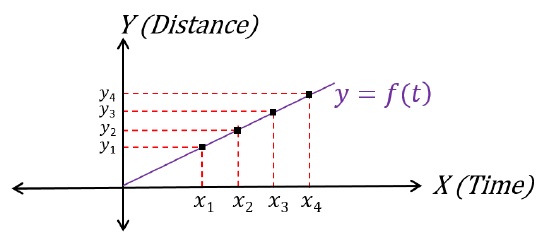
Car is covering equal distances in equal time because it is going at a constant speed.
Therefore, one can say,
(y1 - 0)(x1 - 0) = (y2 - y1)(x2 - x1) = (y3 - y2)(x3 - x2) = (y4 - y3)(x4 - x3) = Constant
Rate of change of distance with respect to time is always same.
Increasing/Non-constant Speed motion
The same car starts to increase its speed of motion.
Now, let’s say, the Distance vs Time plot would look like follows −
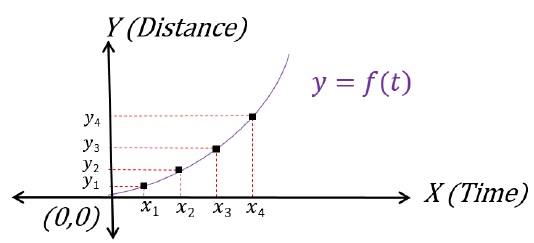
Car is DOES NOT cover equal distances in equal time because its speed is increasing. In fact, the car covers the larger distances every unit time.
Therefore, one can say,
(y1 - 0)(x1 - 0) ≠ (y2 - y1)(x2 - x1) ≠ (y3 - y2)(x3 - x2) ≠ (y4 - y3)(x4 - x3)
Rate of change of distance with respect to time is never same.
Mathematical Analysis of Rate of Change
Consider any two arbitrary points (x1,y1) and (x2,y2) on the plot.
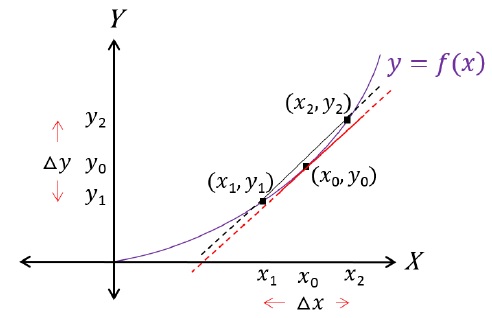
Between points (x1,y1) and (x2,y2), the rate of change can be defined as −
Average Rate of Change = (y2 - y1)(x2 - x1) = ΔyΔx
The result of this average rate of change can be taken as the average speed of the car.
However, the plot of the motion is not really a straight line but, a curve.
Therefore, we are also interested in the value of speed (rate of change of distance w.r.t. time) at every instant (of time) and, not just the average.
We define instantaneous speed of the car at x = x0 as follows −

To physically visualize this, imagine that we start bringing our reference points (x1,y1) and (x2,y2) closer to each other on the curve towards (x0,y0).
When they are very, very close to (x0,y0), the value of both Δx and Δy are very, very close to zero.
The three points are so close that they are almost on a straight line now and there is no curvature left.
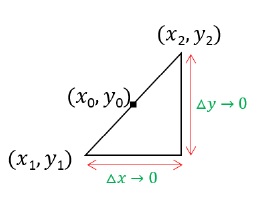
At this point, the rate of change can be defined as −
Rate of Change = lim(x2 - x1)→0(y2 - y1)(x2 - x1) = limΔx→0ΔyΔx = dydx
‘dy’ and ‘dx’ represent infinitesimally small change in ‘y’ and ‘x’ respectively.
This rate of change obtained can also be called the instantaneous rate of change or, instantaneous speed of the car in the case study.
Therefore,
Instantaneous rate of Change = limΔx→0ΔyΔx = (dydx)x = x0
Relating these results to the moving car case study,
Average Speed of the car between time x1 and x2 = (y2 - y1)(x2 - x1) = ΔyΔx
Instantaneous speed of the car at x0 = limΔx→0ΔyΔx = (dydx)x = x0
(dy/dx)as the slope of the tangent
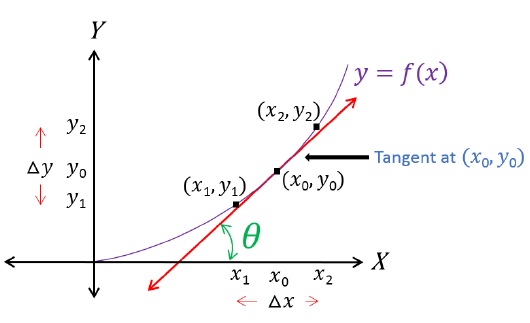
dydx can also be understood as the slope of the tangent to the curve at x = x0.
This is so because dydx is nothing but extremely small value of (y2 - y1) divided by extremely small value of (x2 - x1).
Slope of the tangent is defined as: slope = tan θ, where ‘θ’ is the angle tangent makes with the positive x − axis.
You will learn more about slope in Straight Lines chapter of Mathematics.
(dy/dx) of some common functions
If y = c where c ∈ constant, then dydx = dcdx = 0
If y = xn, then dydx = ddx (xn) = n x(n-1)
If y = ex, where "e" is euler′s constant, then dydx = ddx (ex) = ex
If y = ax, where a ∈ constant, then dydx = ddx (ax) = ax ln(a)
If y = logex = ln x, where "e" is euler′s constant, then dydx = ddx (ln x) = 1x
If y = loga x, where a ∈ constant, then dydx = ddx (logax) = 1x ln a
If y = sinx, then dydx = ddx (sin x) = cos x
If y = cos x, then dydx = ddx (cos x) = - sin x
If y = tan x, then dydx = ddx (tanx) = sec2x
If y = cosec x, then dydx = ddx (cosec x) = - cosec x cot x
If y = sec x, then dydx = ddx (sec x) = sec x tan x
If y = cot x, then dydx = ddx (cot x) = - cosec2x
Addition, Subtraction, Multiplication, Division Rules
d(u ± v)dx = dudx ± dvdx
d(u x v)dx = u dvdx + v dudx
d(u/v)dx = v dudx - u dvdxv2
How to use the formulae - Example
Differentiate: y = sin x + x3 ln x + ex tan x
dydx = d(sin x)dx + d(x3 ln x)dx + d(ex tan x)dx
dydx = cos x + (ln xd(x3)dx + x3 d(ln x)dx) + (tan xd(ex)dx + ex d(tan x)dx)
dydx cos x + (ln x (3x2) + (x3)1x) + (tan x(ex) + ex(sec2x))
dydx = cos x + (3x2 ln x + x2) + (extan x + ex sec2x)
Chain Rule
Let’s say, y = f(t) and x = g(t).
Both the variables are functions of ‘t’.
If we have to calculate dydx, then following method is used −
dydx = dydt x dtdx
This can also be written as −
dydx = dydt x 1dx/dt
Values of dydt and dxdt can be calculated using the formulae mentioned previously.
Chain Rule - Example
Lets say, y = sin t and x = cos t.
Then dydx −
dydx = d(sin t)dt x dtd(cos t)
This can also be written as −
dydx = d(sin t)dt x (1d(cos t)/dt)
dydx = cos t x (1- sin t)
dydx = - (cos tsin t) = - cot(t) = - cot(cos-1x) = - cot(sin-1y)

